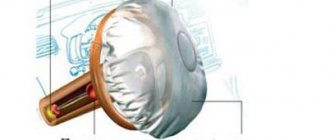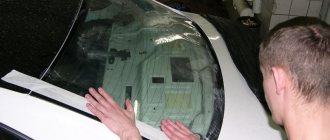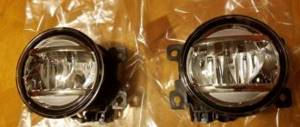Seat belts belong to the passive safety system of a car, and are also designed to reduce the likelihood of injury to the driver and passengers in an emergency. They can be conditionally divided into two groups - according to the type of fastening and the triggering system.
The fastening is:
- point-to-point;
- three-point;
- four-point or more (used mainly in sports cars).
Operating principles:
- static (not currently used);
- dynamic (most common);
- proactive.
The history of belts
The massive distribution of seat belts occurred in the 50s of the last century. This was due to the fact that at ever increasing speeds, accidents began to lead to quite serious injuries and often deaths.
Gustav Lebe, a French scientist, proposed installing five-point seat belts on cars back in 1903. But at that time his idea did not meet with much enthusiasm, and as a result, did not take root. During the research for the best design, more than a dozen devices were invented, but none of them, for a number of reasons, took root. Some are due to the complexity of the design and fastenings, others due to insufficient reliability.
Take, for example, the same two-point seat belts. Fixing the passenger or driver at waist level, in the event of a collision, they did not save them from hitting the dashboard, steering wheel or windshield. After all, the upper body was not fixed at all. Some GAZelle car models still have a similar mount (front seat next to the driver).
The pioneer, whose invention not only caught on, but also became widespread, and later became the progenitor of all modern three-point seat belts, was Nils Bohlin. An engineer from Sweden, who worked on ejection safety systems for an airline, came to Volvo and proposed a three-point system.
Article on the topic: Diagram of the brake system of front-wheel drive VAZ cars
Operating rules
Using a seat belt is as simple and convenient as possible for the driver and passengers. However, even this simple device has its own rules and operating nuances.
- To check if the seat belt is tight enough, place your hand between the belt strap and your body. If there is a noticeable compression on the hand, it means it is tensioned to the required extent.
- Do not allow the tape to twist. In addition to the obvious inconvenience, such operation of the belt will not provide it with proper tension in an emergency.
- If the car was sent for repairs after a serious accident, ask the service specialists to pay attention to the seat belts. As a result of strong and sudden tension, the tapes could lose their strength. It is possible that they need to be replaced, and also check the reliability of fastening of all elements of the device.
- It is recommended to replace seat belts even during accident-free driving at intervals of 5-10 years due to natural wear and tear.
Many motorists try to loosen the belt so that it does not hinder movement. However, an unreasonably weak tension significantly reduces the braking effect of the device, which is why its effectiveness is significantly reduced.
In the event of an accident, an unbelted driver and his passengers can suffer more serious injuries, which are often incompatible with life.
Statistics say that if a person ignores the need to wear a seat belt in a car, then in the event of an accident the risk of serious injury will increase:
- 2.5 times - in a frontal collision;
- 1.8 times – in case of a side impact;
- 5 times - when the car rolls over.
The road can be completely unpredictable, so seat belts can save your life at any time.
Three point static seat belt
The design of this design was simple. Diagonal and waist strap with a lock that was fixed at the hip. The fastening is the same as in a modern car, with the only difference being that the fixation system was static. A significant drawback of this system is the need for adjustment. Having sat down and buckled up, the passenger had to adjust the fastening so that no more than two fingers could fit under the strap. If the length was greater, safety was again at risk. In the event of a collision, the body managed to gain acceleration before it encountered an obstacle in the form of a seat belt.
Inertial and non-inertial seat belts
If you don’t know what inertial and non-inertial belts are, then I will try to explain.
When unfastened, inertia belts If the inertia belt is not fastened, it automatically returns to its place. To fasten the inertia belt, you need to pull it out and secure it in the belt buckle. Currently, and for quite some time now, all cars are equipped with inertial seat belts.
Non-inertia belts are not automatically removed when unfastened, but remain on the seat.
There is a significant difference in how to properly fasten with an inertia belt and a non-inertia belt. If the inertial belt automatically adjusts its length and holds the person tightly on its own, then for a non-inertial belt it is necessary to first select the length of the strap. When fastened, the length should be such that your palm fits between the strap and the chest. Do not loosen the belt too much or tighten it too much, as this may cause injury. If you suddenly have to use a car with regular belts, be sure to adjust their length to suit you.
Evolution of the belt
Inertial three-point seat belts, which replaced static ones in the 70s, were a breakthrough in the field of safety. They not only corrected the statistics of deaths and injuries in road accidents, but also almost doubled the number of people wearing seat belts. After all, there is no longer a need to adjust the belt when getting into the car. I sat down, buckled up, and the inertial reel itself took away the excess.
The design is such that in the event of an accident, the ball or pendulum mechanism of the reel fixes the tape and prevents it from unwinding, thereby securely holding the body. The inertial belt reel device blocks the belt when the car rolls over, in the event of a roll or skid, as well as during sudden braking. It would seem that three-point seat belts are ideal in terms of safety, but like any other, they have a significant drawback.
This is a delay in response, and in an accident, when the count is a fraction of a second, this delay can be dangerous. In winter, when a person is dressed in a large amount of clothing, the device creates that dangerous space between the belt and the body, as a result of which the body manages to gain serious speed. Therefore, the next stages in development were systems that operate proactively.
Article on the topic: Starter Vaz 2114
Seat belt fine
Neglect of safety belts is fraught with loss of health and even life, because no one can guarantee that an unfastened person will stay in place during an accident and at the moment of “recoil.” In comparison, the fines seem small - one thousand rubles for those sitting behind the wheel and half as much for those sitting in the passenger seat.
Important: a traffic inspector can fine you for neglecting the rear fastenings only if they are provided by the manufacturer!
For more details see the link
Belt pretensioners
The first in this area were squibs, which, receiving a signal from the control system, when triggered, tightened the seat belt, the length decreased, reducing that same dangerous distance. To prevent the tension from being critically strong, the tensioner design contained a force limiter, a device that, when the load on the chest was exceeded (approximately 150 kg), began to give slack, thereby weakening the belt’s dead grip. The only drawback of these devices was and remains their disposability. After activation, the squib must be replaced.
The system of electric tensioners is completely free of this drawback. They are able to perform this action repeatedly. Working in conjunction with radars and sensors, they are able to determine critical proximity even before the moment of collision, which means protecting passengers and the driver in advance. If the device detects a danger, the length of the belt is shortened and the person is securely fixed in the chair.
Belt stops
During an accident, strong overloads inevitably occur, which affect not only the car, but also the people inside it. In order to reduce the resulting load, seat belt force limiters are used.
When an impact occurs, the device releases the seat belt, providing the smoothest contact with the deployed airbag. Thus, first, the tensioners fix the person on the seat as firmly as possible, and then the force limiter slightly loosens the tape to such an extent as to reduce the load on the person’s bones and internal organs.
Types of devices
The most convenient and technically simplest way to limit the tension force is a loop-stitched seat belt. Extremely high loads tear the seams, causing the belt to increase in length. But the reliability of holding the driver or passengers remains the same.
Loop limiter
A torsion bar can also be used in cars. A torsion bar is installed in the seat belt reel. Depending on the applied load, it can twist to a greater or lesser angle, preventing peak forces.
Torsion limiter
Even seemingly insignificant devices can improve the safety of vehicle occupants and mitigate injuries sustained in a crash. The simultaneous action of the pretensioner and limiter in an emergency helps to securely fix the person in the seat, but at the same time do not unnecessarily compress his chest with the belt.
Other types of belts
There are also four-point and five-point harnesses. These are sports seat belts and are used to securely secure racing drivers. The first has four fastening points, and the second, respectively, five. The five-point seat belt is also used in child car seats that have recently become mandatory. This mount most reliably fixes the body and distributes the load on it.
Another variety has appeared called inflatable seat belts that fill with gas during an accident. The fastening of such belts is mainly three-point.
What conclusion can be drawn from all of the above? Many minds are concerned about the safety of the driver and passengers, many people are working to improve safety systems designed to save our lives and health. It's up to you to decide whether you should neglect this, but when getting into the car, remember that everything possible has been done for your safety; all you need to do is buckle up.
Share with friends on social networks:
Telegram
The structure and principle of a three-point belt
The modern three-point belt saw the light of day thanks to the talented inventor Nils Bohlin , who worked for the Volvo concern. After numerous studies, he concluded that the highest degree of safety can be achieved by using two straps at once. The first, obliquely crossing the body, fixes it, and the second is used for fixation in the belt. This is how the V-shaped design with three points saw the light, which became a real revolution. The inventor himself said that he had found the best compromise between effective protection and comfort. According to the German patent office, the three-point design was included in the eight most useful and valuable inventions for humanity of the twentieth century.
As you can see, this type of insurance has a long history. Moreover, it was not always rosy. Despite numerous evidence of their benefits, statistical data and expert recommendations, drivers themselves were reluctant to use them. They said they felt connected. They were also not welcomed by car manufacturers, arguing that they were unnecessary pain and increased costs. However, the fact remains a fact. This is a recognized means that is mandatory, and neglecting it leads to at least a fine for seat belts, not to mention risks to life and health.
The modern design is a tape made of durable polyester that can withstand high tensile loads. It is made in the form of a strap with adjustable and non-adjustable attachment points.
Each design has a reel with an inertia mechanism, a pretensioner and a limiter. The seat belt buckle deserves special attention, the design of which, like everything talented, is very simple. It allows you to quickly fasten, hold securely and just as quickly release the fastening. The retracting device is a ratcheting mechanism, and emergency locking is provided by a special sensitive element, the basis of which, as a rule, is an ordinary metal ball. When it starts to move, the reel is fixed by a special system of levers. The main load falls on the fastening bolts. Therefore, they are made of a particularly hard alloy and attached directly to the car frame.
The system responsible for the tension of the strap is interesting. Its operation is ensured by a flywheel, which is mounted on the axis of the coil. In fact, the mechanism is a disk that ensures smooth operation. However, if a jerk suddenly occurs, the disk begins to overcome the force of friction, and at the same time a large load appears on the screw surface. As a result, the disk moves and the ratchet is blocked. In other words, during a frontal impact or sudden braking, the front seat belts prevent the driver and passenger from hitting the windshield and dashboard. You often hear the question of which seat belt is most effective at high speeds. We must understand that any device has a limit to its effectiveness. Numerous experiments and tests on special stands give specialists the right to assert that at speeds of more than 200 km/h, any standard belt, even the most durable, will be of no use. Unless, of course, it is a special design that is used in racing cars.
Experts say that the use of such structures reduces the risk of injury in a frontal collision by more than 2 times, in a side impact by 1.8 times, and in a vehicle rollover by as much as 5 times . The following calculations also speak in favor of a calm, non-extreme ride. In a frontal collision, occupants receive the same injuries as if they fall from a height onto a hard surface. Moreover, the higher the speed of encountering an obstacle, the greater the degree of injury. For example, at a speed of 40 km/h the height is more than 6 meters, at 60 km/h it will already be 14 meters, and at 80 km/h it will increase to 25 meters. According to studies, standard seat belts reduce the likelihood of death in an accident by 50% and reduce the risk of injury by 65%.
Replacing the pretensioner
What you need
For those who still decide to do it themselves, you need:
- a set of keys;
- hacksaw;
- screwdriver;
- calipers;
- welding machine;
- Bulgarian.
Attention! It is strictly forbidden to disassemble the pretensioner - it is dangerous!
Step by Step Actions
The following is a chain of steps:
- The car is de-energized . The seat is moved back and the bolts with which it was attached to the floor are unscrewed, then forward until it stops, after which you can unscrew the rear bolts.
- The pretensioner wiring is located under the seat . Disconnect the connector by first pulling out the latch perpendicularly. The seat is pulled out through the front door opening.
- The removed seat is placed “upside down” and the pretensioner screw is unscrewed . Remove the latch, then the pretensioner itself.
- Cut off a part of the pipe (1 cm) before the piston and a little after - closer to the base. This is necessary in order to remove the clogged piston and the metal balls that secure it.
- Pull out the piston with the cable , set it in the desired position and weld the cut points. The seams are cleaned, then the parts are primed and painted over.
As you can see, the task is not an easy one. A car owner, in addition to knowing the structure of the car, also needs to have welding skills.
So, you can restore a triggered pretensioner, but it’s better not to do it yourself. The most harmless thing a craftsman risks is to completely ruin the mechanism and make it even worse.
Issues relating to motorists' rights are often more important than they appear at first glance. A driver may lose his license or suffer other severe penalties due to ignorance or misinterpretation of laws and regulations. Do not be lazy to dive deeply into the essence of the issue being studied, do not hesitate to ask advice from professionals.
Any vehicle component does not last forever and tends to break. Sometimes this is not so noticeable and may appear after some time. In other cases, such as with a seat belt, the problem will be noticed immediately. What to do if the seat belt does not extend? For what reasons could this happen? Find out more details below.
Child seats
If you plan to carry a child in your car, then a child seat is a very important safety element (one might say the most important).
Transporting a child without a special seat is excluded, because In this case, the child can receive very serious injuries in the event of an accident or sudden braking. If the child is not fastened, injuries may occur as a result of hitting elements of the car interior, and if fastened, then from a seat belt, which is designed for an average-sized adult, and not for a child.
Special devices have been used to protect children for a long time . However, there are currently 2 types of them:
1. Seats 2. Restraints
The chair is shown in the picture on the left. It looks quite reliable. The child's position in the seat is secured using a 4-point seat belt. This belt distributes the load on the child more evenly. Also, child seats have special side cushions that protect the head.
The second picture shows a child restraint . As you can see, it is an overlay for a standard car seat belt. At the same time, adult belts seem to be adjusted to the size of the baby. But what remains surprising is the fact that this overlay is attached with buttons. In appearance, it seems that under heavy load the buttons will not withstand and, therefore, the belt will injure the child.
To protect yourself from a fine for transporting a child without a special restraint device (500 rubles), you can use any of the devices. But to ensure the safety of the child , I recommend using a chair. You shouldn’t skimp on your child’s safety.










